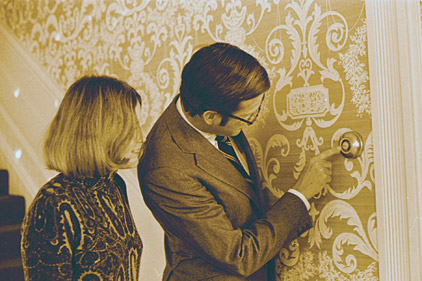That exponential growth is expected to continue. By the close of 2016, an estimated 192.4 million Americans — or approximately 58.5 percent of the U.S. population — will palm a smartphone on a regular basis.
A recent study, conducted by O2, reveals that smartphone users spend at least two hours each day on their devices, surfing the Internet, utilizing social media, listening to music, gaming, and performing other activities. One of those other activities: setting their thermostat.
Recent Improvements
Thermostats and control devices are no longer recognized as just HVAC devices; they’re now recognized as consumer electronic devices and manufacturers are harvesting this notion through the creation of state-of-the-art equipment.
“Over the last five years, thermostats have changed dramatically,” said Kyle Golden, product manager of controls, Lennox Industries. “As adoption of smartphones and tablets has increased, consumer expectations have changed. Touch enabled devices and easy-to-use interfaces are now the norm. Technology advancements like Wi-Fi connectivity and the ability to have control through the cloud are no longer limited to just early adopters; they have transitioned to the mainstream.”
Cutting-edge thermostat technology has nearly replaced standard BAS systems panels with multi-input and output points, said Paul Balazovjech, president, Spartan Peripheral Devices. “Thermostats in commercial HVAC applications have evolved into complex networked controllers,” he said. “These new room controllers are not only capable of sending and receiving information from the central front end to control room devices, but can collect data for analyzing trends for optimum building control management.”
While climate-controlling devices have emerged smarter and more intuitive, Mike Reilly, executive vice president, EWC Controls, said his staff strives to keep things as simple as possible for the user. “The manufacturers of these devices have been able to use the technology available to put more computing power behind them and provide vast amounts of data for the installer and end user,” he said. “One of the most convenient steps forward has been the ability of these devices to simplify the installation process. EWC Controls has taken our controls products and simplified wiring schematics and installation procedures in the last five years due to the advancement in technology.” White-Rodgers is also working on simplifying the installation process by making their new devices accessible across most systems.
“With concerns about rising energy costs, consumers are looking for wireless thermostats that are easily installed and work with both new and existing systems,” said Geoff Godwin, vice president of marketing, White-Rodgers. “Our next generation Emerson Blue Easy Install™ thermostat wired, and the wireless version of our Emerson Blue Easy Reader™ thermostat, is compatible with most systems, not just high end communicating systems.”
Predicting the Future
While thermostats and controls have certainly upgraded with the times, many manufacturers predict even further advancement is on its way. “The next five years will change the face of HVAC controls, especially the good, old thermostat. It will be mobile, agile, and intelligent; and will be a major partner in energy conservation,” said Dennis Laughlin, president, Arzel Zoning Technology. “Increasingly we will see web page control panels, smartphone-accessed controls, and the use of sensors on walls instead of the normal reporting thermostats.”
Marc Zipfel, director of product marketing, Mitsubishi Electric Cooling & Heating, said he believes thermostats and controls will likely become even more discrete, convenient, and portable. “Smart device apps will grow more sophisticated as technology advances, providing homeowners with more monitoring and control capabilities,” he said. “A greater number of thermostats and controls will be accessible via mobile apps, giving users more options to measure and monitor their HVAC systems remotely. Additionally, as homeowners work to use less energy and save money on utility bills, I predict that thermostats and controls will give users the ability to more closely measure HVAC energy usage.”
Push-button controls have transitioned to touch-screen controls and monochrome touch-screen devices are now being replaced with color touch screens, said Karl Mutchnik, solutions manager, residential solutions, Ingersoll Rand. He believes HVAC controls will have a much larger influence on home operations. “In the next few years controls will become a system differentiator and will truly become the home control,” he said. “Remote access will allow you to stay connected with your home like never before.”
Publication date: 9/17/2012



Report Abusive Comment